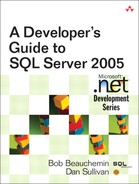Foreword
THE SQL SERVER landscape has changed dramatically over the years. When I started working on SQL Server in 1988, while still at Ashton-Tate, all we had were the base RDBMS-level functionality inherited from Sybase, no real extensibility, some arcane tools like ISQL and BCP, and a single database access API named DB-Library. You had to write your applications in C, squeeze all memory out of your MS-DOS based client to be able to load the network stack, and enable named pipes so you could communicate with the Intel 80286–based PC running OS/2 with LAN Manager and the Ashton-Tate/Microsoft SQL Server 1.0. Twenty-two TPC-B transactions per minute later, we proved that you could build client-server–based database applications on top of a PC platform. In reality, it would take many more years before the environment was ready to host real customer applications.
In 1996, I moved to Redmond, Washington, to join the SQL Server development team. As Lead Software Design Engineer in Test for the Storage Engine, I was responsible for tasks that included the validation of the on-disk conversion from 2K to 8K pages. The new page format was just one of many architectural changes that drove the SQL Server 7 release. Changes ranged from row-level locking, which triggered a different logging and recovery scheme, to the brand-new query processor. These were just a few of the key aspects that laid the foundation for SQL Server as we know it today.
While working on SQL Server 7, we were very cautious not to make too big a leap between SQL Server 6.x and SQL Server 7. We tried to keep the DBA and developer experience as stable as possible. Granted, data access APIs came and went—DAO, RDO, ADO, OLE-DB, ODBC, and ADO.NET—but from a server perspective, we kept the changes to a minimum. The amount of new syntax in the form of Data Definition Language (DDL) and Data Manipulation Language (DML) and the number of new data types were pretty limited.
SQL Server 2000 introduced limited XML support, which for many set-based purists was a real shock or maybe even an insult, depending on their point of view. This was just the tip of the iceberg waiting to be revealed by the introduction of SQL Server 2005, however. The changes between SQL Server 6.x and 7 or 2000 were small compared with the huge new feature set of SQL Server 2005.
SQL Server 2005 expands in almost every possible dimension: server-side extensibility through the SQL-CLR integration; support for queue-based and message-based constructs and operations in the form of Service Broker; first-class XML integration as a storage object, but also through query extensions in the form of XQuery; and new T-SQL constructs like exception handling, common table expressions, output clauses, and new data types. On the client programming side, the list is analogous, because a lot of the new server-side features have corresponding supporting infrastructure to make them accessible to the developer.
All this new, changed, and enhanced functionality is great but yields one very important question: Which technology do we use, when, where, how, and why? What is the appropriate use of SQL-CLR, XML, Service Broker, Web Service endpoints, and so on? These and many more questions are the ones you will—or should—ask yourself when designing and/or implementing SQL Server 2005–based applications.
This is exactly why this book will be playing such a crucial role in building new systems that leverage SQL Server 2005. Not only does it provide you the overview that every (database) developer and even DBA should understand on how to leverage the new developer-oriented features and functionality, but it also provides you much-needed guidance in decisions like T-SQL versus SQL-CLR usage, how to leverage message-based processing, and how best to use XML inside the server.
Most important, this book has already proved itself. When this book first appeared during the beta stages of the project, it quickly became the de facto standard for developers who needed to educate themselves on SQL Server 2005. Bob and Dan have done a great job of updating the book—incorporating user feedback and reflecting the many changes between the first book and the final release of the product. The many samples do a great job of explaining the usage models and hidden aspects behind the features. Last but not least, many colleagues at Microsoft helped by reviewing the content to ensure its correctness and completeness so that you can use it as the guideline for designing and implementing your SQL Server–based systems.
Bottom line, this truly is A Developer’s Guide to SQL Server 2005, providing you the knowledge, examples, and use cases to make the SQL Server 2005 implementation really happen!
Gert E. R. Drapers
Development Manager
Visual Studio Team System
Microsoft Corporation
Redmond, Washington
January 2006
